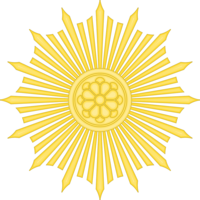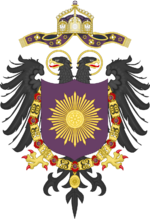Achysian Monarchy
This article is incomplete because it is pending further input from participants, or it is a work-in-progress by one author. Please comment on this article's talk page to share your input, comments and questions. Note: To contribute to this article, you may need to seek help from the author(s) of this page. |
Exalted Achysian Monarchy | |||||||||
|---|---|---|---|---|---|---|---|---|---|
| 1466–1804 | |||||||||
| Motto: Fiat justitia, ruat caelum Let justice be done, through the heaven's fall | |||||||||
| Anthem: All hail thee, King of Kings! | |||||||||
| Capital | Veranium | ||||||||
| Common languages | Achysian, High Elyrian | ||||||||
| Religion | Vayonism | ||||||||
| Government | Mixed, functionally Absolute composite monarchy | ||||||||
| Emperor | |||||||||
| Grand Chancellor | |||||||||
| Legislature | Imperial Court | ||||||||
| Historical era | Various | ||||||||
| May the 16th 1453 | |||||||||
• Established | May the 16th 1466 | ||||||||
| May 13th 1809 | |||||||||
• Disestablished | May the 13th 1804 | ||||||||
| 16 May 1809 | |||||||||
| Currency | Auriol | ||||||||
| |||||||||
| Today part of | Ichoria Kathia Achysia Educandi Grothbord Euria Florencia | ||||||||
| |||||||||
Part of a series on the |
|---|
| History of Achysia |
 |
| Timeline |
The Achysian Monarchy, officially known as the Exalted Achysian Monarchy, was a union of multiple realms brought together by the Radiant Crown, the Achysian line of monarchs. Being centered around the leading Achysian imperial title, this composite monarchy was most often equated with Achysia itself, even as the Radiant Crown controlled important territories throughout Aurora and a significant overseas empire, being one of the first realms to become known as the empire on which the sun never sets.
Achysia was the cultural, political, and military center of this empire throughout most of its history, but the empire was not exclusively Achysian. Imperial authority was moved away from Achysia multiple times, with the best known period being that of the personal union with Ichoria. While the territories of the Achysian realm were ruled under a despotic administrative monarchy, the feudal relations in this union of crowns led to many of the member realms maintaining their own administrations, despite the historical attempts of several monarchs to centralize or reorganize the empire. As such, the monarch's power varied from realm to realm, and power was delegated away from Achysia to a system of viceroys, courts and councils.
After its development from the last remains of the Veranian Empire, the Achysian state experienced a series of military expansions and a marked decline of its previous medieval, Elyrian identity. The Achysian protection of the Haliarch granted its monarchs a significant power in the religious life of Aurora, and this support from the Faith was crucial in the initial Achysian colonial expansion, which was done in the name of expanding Vayonism and converting the natives. The colonial empire in turn granted the Achysian monarchs the power they needed for their continental policies. The rebirth of the idea of Elyrian unionism, and Achysian support for the Haliarchic dogmatism played important roles in the beginning of the Wars of the Faith, a series of interconnected conflicts which scarred Aurora and its colonies for nearly a century.
The Wars allowed the Achysian Monarchy to gain a dominant position on the continent, which was disputed by its main rival in Kathia. Despite setbacks during the Wars, the personal union with Ichoria allowed Daeron the Great to retain his empire's dominance through a series of brutal military campaigns. Even through the imperial center of power initially moved to Azhara, the forced inclusion of the Kathic throne in this union of realms directly led to Daeron's attempts to restore the Elyrian Empire of old - the concept of a universal Auroran monarchy. These wars however severely weakened the empire, and the centralizing reforms were incredibly unpopular outside of Achysia. Daeron's son and successor, Kaeron the Martyr, oversaw the rebellions of Ichoria and Kathia and a military disaster, which after his death permanently ended Achysia's dreams of continental hegemony.
Despite a period of decline, and an initial fall towards the status of a secondary power for Achysia, the following monarchs focused on reforming their economy and colonial empire, which led to a certain recovery in the 18th century. Continued imperial failures in Auroran affairs however led to an increased diplomatic isolation and internal decadence. Despite all of this, the Achysian monarchs refused to acknowledge the major political and social changes that led to upheaval throughout Aurora towards the end of the 18th century. Still firmly centered on ideas of despotism and caesaropapism, the Achysian crown attempted to act as a defender of Auroran absolutism and of the old order, leading to several conflicts with the rising republics of Kathia and Thynia. A combined invasion in 1804 proved too much to handle for the Imperial Army, with several crushing defeats resulting in the deaths of emperor Aelius and Prince Gaeros, leaving the realm without a monarch.
This marked the end of the Achysian Monarchy, with the remains of the country embroiled in a civil conflict between a client republic in Veranium, a loyalist Supreme Regency Council and religious rebels. The forced invasion and the suffering of the Achysians in this period however doomed the cause of republicanism in the country, the civil struggle ending with a reactionary victory in 1823, and the foundation of the modernized but still absolutist Achysian Empire.


